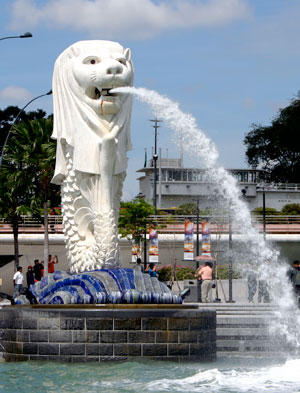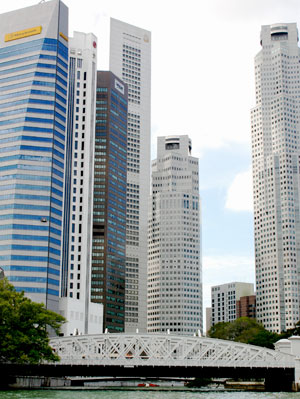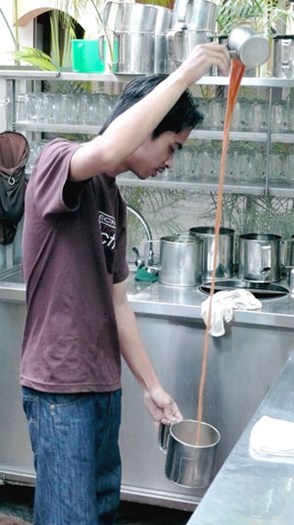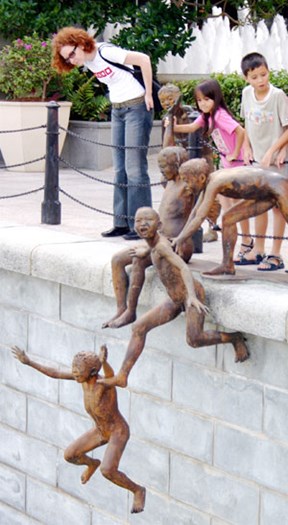REPUBLIC OF SINGAPORE — Long considered the melting pot of Asia, this city is boiling over with a new-found excitement these days thanks to its ongoing transformation from staid business capital to Asia’s new sun and fun central.
Hey, even Singapore’s well groomed business tycoons are loosening their ties in anticipation of what’s about to happen here.
“People will see a whole new side of Singapore in the next few years,” predicts Singh, the handsome guide who is taking me to the Urban Redevelopment Authority building on Maxwell Road where I’ve been told the future of Singapore is on display in miniature right now.
Singh can hardly contain his excitement as we enter a large hall within the Urban planning building where Singapore’s striking skyline – or what it will look like in the not too distant future – greets visitors. The “model” city is one of the most amazing displays you’ll ever see.
On display are new, boldly-designed office towers and state-of-the-art entertainment venues that will soon take their place alongside the city’s present award-winning architecture, and will be accented by new canals, bays and golf courses, all part of the remaking of Singapore.
“We are spending billions (one estimate has the Singaporean government investing over $20 billion U.S. over the next decade on new infrastructure) and my city will soon become the greatest destination in Asia,” boasts Singh.
Planned entertainment and gambling venues in the city’s downtown core and on nearby Sentosa Island won’t just rival similar structures already in existence, they’ll surpass them.
In typical Singaporean style, they take what’s already out their and make it better. There’s no better example of that than the Singapore Flyer, a giant Ferris wheel-type structure that, at an eye-popping 165 metres tall, makes its chief rival, Britain’s London Eye, which stands just 135 metres high, look down right small.
The Singapore Flyer is the cornerstone of an ever-changing Singaporean skyline and will offer riders breathtaking views of a city that will soon feature some of the most futuristic architecture in the world.


Above: The Merlion Statue is the symbol of Singapore, which boasts a forest of modern office towers.
Once inside the Flyer’s glass pods, riders will get to see the marvelous structures that make up the Integrated Resort at Marina Bay Sands, the multi-billion-dollar entertainment complex being built by the Las Vegas Sands Corporation. The Integrated Resort complex is more 22nd century than 21st and experts say this complex will be the envy of every city in the world.
Marina Bay Sands will boast state-of-the-art convention space and is expected to make Singapore even more attractive than it already is to the lucrative business and leisure markets. With a 110,000 square metres of floor space, the Sands will undoubtedly attract lots of attention from major international conventions in the future.
The Sands’ project is also expected to add an additional $2.7 billion to Singapore’s annual gross domestic product and generate at least 30,000 jobs.
In addition to the Marina Sands project, Singapore is attracting lots of new, multi-star hotel properties, including the famed St. Regis and Capella brands, to go along with an already-impressive lineup of hotel chains now in the city state.
The Capella Singapore will be built on enchanting Sentosa Island while the St. Regis, slated to open in late December, 2007, will be located in the heart of the downtown core on Orchard Road.
The 299-oversized rooms and suites at the St. Regis will come dripping in total luxury and take their place alongside Singapore’s already legendary list of great hotels, led by the famed Raffles, home of the Singapore Sling cocktail and a place where every major author have laid their heads over the centuries.


Above: You will see some strange sites while walking around Singapore where even pouring tea is unique.
Add to that Singapore’s entry into the Formula One racing world – it will hold the first ever FI night race next year and a new track will open in 2011 – and you can see why people are saying this place is defiantly in the fast lane of development. It’s not the first transformation Singapore has undergone since its discovery by ancient fishermen. The first came under the guiding hand of Englishman Sir Thomas Stamford Raffles who laid the framework for the economic giant Singapore would later become. Then under its first Prime Minister, Lee Kuan Yew, who took power in 1959, Singapore became a model for the world – he even managed to synchronize all the street lights.
While the future looks bright for Singapore, the present looks pretty impressive and Singh, who introduces me to a local delicacy called kaya toast - egg, coconut and sugar that is spread over bread in the morning – offers to show me what makes this island nation so unique amongst its Asian neighbors.
“Raffles was a visionary,” said Singh, who makes his home in Singapore’s vibrant 12-block Indian district around colorful Serangoon Road.
In his grand plan for the city, Raffles first divided it into ethnic enclaves where the majority Chinese shared space with the Indian and Malay populations. While each retains their own distinct community and culture, a great attraction for tourists, each offers something unique and interesting.
Singapore is really a city of villages. There’s Chinatown, Little India and Arab Town, made up of Muslims who came from Malaysia, a causeway away.
In his grand plan for Singapore, Prime Minister Lee Kuan Yew wanted to make this the most beautiful city in Asia and succeeded by incorporating a series of grand parks in his blue print. That’s earned Singapore the nickname “Garden City”. “After we finish our coffees, I will take you to Arab Town,” said Singh, referring to an area of the city where Muslims sell tasty treats like sates from roadside stands and where the skyline is dominated by mosque domes.
Singh drops me off on Arab Street and tells me to wander the area but cautions: “Don’t pay too much for the carpets.” It’s hard to resist the handmade creations being offered in the shops here, especially the woven carpets that sell for a fraction of the price charged elsewhere. There’s a fairly large outdoor pedestrian mall leading to the main mosque, where people kneel on the sidewalk pointing to Mecca and pray. About an hour later, Singh returns. I ask him to open the boot (trunk) of his car so I can store my small carpet.
“I knew it was dangerous leaving you here alone,” said Singh with a sly smile.
As we make our way to Chinatown, Singh tells me Singapore’s population breaks down to 77 per cent Chinese, 14 per cent Malay, 7 per cent Indian and 2 per cent Eurasians and Perenakans, a mix race of Chinese and Malay. The dominate languages here, in order, is Chinese, Tamil, Malaysian and English, which is still compulsory in Singapore’s schools. Chinatown is made up of mostly shops and restaurants, where you can sample traditional dishes like spicy crab, a delicacy that comes swimming in an atomic dark sauce that explodes in your mouth. Busy Sim Lim Square is where you’ll find a 24-hour department store that sells everything from computers to combs.
In recent years, Singapore’s traditional eateries have faced stiff competition from invading North American fast food restaurants. McDonalds alone has over 125 outlets in this compact city of four million and is one of the highest employers – 6,000 staff. But with 3,600 restaurants in total, there are still plenty of places left to sample local delicacies. After all, Singaporeans will tell you their favorite pastime is eating.
After a good night’s sleep at the Fullerton Hotel, the country’s former post office and now one of its top 5-star properties, Singh picks me up early for a tour of Little India. The real India is just a short plane ride away so many people from Delhi and Mumbai come here to shop.
This district was actually created after one of the few minor conflicts Raffles faced during his planning of Singapore. The Indian population was granted space near the city’s port but quietly rebelled and moved to this district so they could raise their cattle.
The only cows you’ll see along Serangoon Road, the main thoroughfare in Little India, are the ones carved into the ornate temples that line this route.
Serangoon Road is busy most days with women in colorful saris scurrying about the outdoor market buying spices and vegetables for their dinner tables. The day Singh took me to his home district the streets were crowded with people getting ready for Deepavali, the Hindu festival of lights. Serangoon Road was decorated with banners and lights and local temples were full with worshippers.
The temples are the main attraction in Little India. Their pyramid roofs are decked out with intricate carvings that number in the hundreds. The handsome Sri Veeramakaliamman Temple was built in 1885 and is the city’s oldest.
“Do you mind if I take time to visit the temple?” asked Singh, who removed his shoes before entering the beautiful building with the golden interior.
Singapore is one of the busiest cities in the world, with 23 million people passing through delightful Chiang International Airport each year and over 300 ships dock here each day. It’s also the richest community in Asia, which is reflected in the number of high-end stores and cars you see here.
The first impression people get of Singapore is amazing Changi International Airport. It’s been voted the No. 1 airport in the world many times and is a technological marvel, with high-speed sidewalks, security desks, free internet service for waiting passengers and lounges that resemble 5-star hotels.
This is one airport you don’t mind waiting for a connecting flight. But you don’t have to sit at the airport waiting for your next flight either – you can spend that time sailing down the Singapore River, a perk offered passengers who have a long – at least five hours - layover.
The Singapore River is the lifeline of this city nation. While not as congested as it was during the country’s early years, the river is still active with bum boats ferrying tourists and goods from one end of Singapore to another.
Bum boats, Singh tells me, were once called “bump boats” because there were so many of them on the river that they would bump into each other all the time. Old photographs show the river so congested with the tiny wooden vessels that people would get across the river by jumping from one boat to another.
“No one knows why the “p” was dropped from the name, though,” says Singh as we board out tiny bum boat for a one-hour cruise on what I observe as “the cleanest river I have ever seen.”
How clean is the Singapore River? Well, they vacuum it every day. No kidding. A bright red boat, with a large vacuum hose attached, sucks up any debris that may have floated into the river overnight.
The hour-long cruise is one of the highlights of a visitor’s stay in Singapore. The river has been the city’s lifeline from the time the first curious fishermen sailed down it and decided to set up camp here.
From that, Singapore has grown into the Lion of Asia, complete with a Merlion mascot that has become the symbol of this economic giant. The Merlion – half fish, half lion – was the creature the earliest fishermen said they saw when they first sailed up the river – a legend that of course was false but hey, it kept others from the rich fish stocks found in these parts. Our captain indicates its time to set sail and soon we are passing under one of the many ornate steel bridges that connect Singapore’s two sides. The first, Cavenagh Bridge, is the most impressive. The steel used to make the bridge was brought here from Scotland a century ago.
At times during the cruise the sun was blocked out by the massive steel and glass towers that have grown up along the river. Many of the futuristic structures were designed by world famous architects like I.M Pei.
The name Singapore, by the way, comes from the Chinese words “sing” meaning lion and “pore”, meaning river.
The cruise reveals the artistic side of Singapore with many imaginative sculptures lining the concrete shoreline. Our favorite was a rust-colored one depicting children jumping into the river. It gets many peoples’ attention but then again a series of bronze statues showing life in early Singapore are pretty spectacular as well.
Soon we drift into Singapore Bay where the world famous Merlion fountain spits out a steady stream of water. Mighty high-rise buildings make a dramatic backdrop for the Merlion, which overlooks the city’s newest addition, the Esplanade, an innovative domed theatre that has been compared to Sydney’s Opera House for ingenuity in design.
Sailing back from whence we came, we pass Boat Quay, which comes alive at night with restaurants and clubs. Many of the city’s best parks can be seen from our bum boat vantage point. Each features lots of trails where people are encouraged to walk in botanical settings that are simply awesome. In all, Singapore boasts over 200 square miles of parks and gardens. The bum boat then sails into Clark Quay, a new entertainment area crafted out of the old warehouses once located here. The shutters on the warehouses have all been painted bright colors and many are being turned into high end restaurants and condo complexes.
Singapore also boasts one of the most fascinating bird sanctuaries in the world, the Jurong Bird Park, home to over 600 colorful species. The award-winning park, a short ride from downtown, is a wonderful escape from the hustle and bustle of one of the world’s most vibrant cities. It opened in 1971 at a cost of almost $4 million but now has become one of Singapore’s biggest tourist attractions, with over 1 million visitors a year. One of the featured attractions here, besides the birds, is the world’s largest man-made waterfall.
In all, almost 10,000 birds reside at Jurong Bird Park and as you can imagine, the park’s colorful setting is a favorite with wedding parties.
As mentioned earlier, Singaporeans love to eat and they have a smorgasbord of dishes to choose from.
One of the most popular pastimes with locals and tourists alike is to participate in the nightly Food Safari. Each night guides take people on a hunt for the best of Singapore’s spicy ethnic food, prepared in the colorful and diverse neighborhoods that make this city one of the most delightful in Asia to visit.
“Our first stop will be the Chinese district,” says Singh.
Soon we enter Smith St., where the air was punched with exotic culinary smells coming from a collection of eateries. Smith St. is actually referred to as Food St. by the locals because of the high number of restaurants on it.
There Singh introduces us to rojak, a fried pancake consisting of fruits and vegetables that comes covered in a delicious peanut sauce and fried carrot cake. No, this is not the carrot cake North Americans are used to. This one is actually more omelet than cake and is made with eggs, Chinese radish and green onions.
“We can’t eat too much here because we have many other places to visit,” says Singh, who passes us a Tiger beer to wash our samples down with.
It was time to move on to the next food stop, Boon Tat St., in the city’s dynamic financial district. Boon Tat is closed every night and the Malay population sets up shop and offers tantalizing satays to hungry passersby.
Skewered meat and chicken is marinated in a bath of ingredients and trying to eat just one of these tasty treats is almost impossible.
The food safari is just part of the night fun in Singapore. There’s also late-night shopping along Orchard Road that goes on until midnight.
Then there’s the nightlife in areas like Duxton Ave., where you can pull up a chair at one of the 75 or so pubs located in the district.
Singapore is truly a city state that never sleeps.
Why?
Because there’s just too many things to do here – day and night.